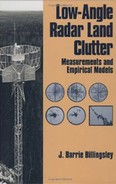FOREWORD
MIT Lincoln Laboratory was founded in 1951 to develop a strategic air-defense system for the United States. The Laboratory engineers of that era quickly found that ground clutter greatly limited the performance of their radars. Consequently, they pioneered the development of Doppler processing techniques and later digital processing techniques to mitigate the effects of ground clutter. The Laboratory returned to the problem of air defense in the late 1970s with a major program to assess and ensure the survivability of U.S. cruise missiles. Once again ground clutter proved an important issue because a low-flying, low-observable cruise missile could hide in ground clutter and escape radar detection. The new challenge was to confidently predict low-grazing angle ground clutter for any number of specific sites with widely varying topographies. But the understanding of clutter phenomena at this time certainly did not permit these predictions. Therefore, with the early support of the Defense Advanced Research Projects Agency and later with the support of the United States Air Force, the Laboratory set out to make a major improvement in our understanding of ground clutter as seen by ground radars.
Barrie Billingsley was the principal researcher at the start and I was the director of the overall Laboratory program. I recall telling Barrie to archive his data, document his experiments, calibrate his radars, and collect ground truth on his many test sites so that he could write the definitive textbook on low grazing angle ground clutter when our program was finished. I would say that Barrie has delivered magnificently on this challenge. I am delighted to see over 300 directly applicable charts characterizing ground clutter backscatter in this book.
I confess that I had expected this book to appear about 10 years after the start, not 20 years. The long gestation period reflects the enormous technical problem of capturing what really happens at low grazing angles and the fact that Barrie Billingsley is an extremely meticulous and persistent researcher. He did stretch the patience of successive Lincoln Laboratory program managers, but he pulled it off by teasing us each year with additional insights into these complex clutter phenomena. We greatly admired his research abilities and his dedication to the task of unfolding the mystery of low grazing angle ground clutter. We had heard the violins and the horns and the woodwinds before, but now we could understand the whole orchestration—how frequency, terrain, propagation, resolution, and polarization all operated together to produce the complex result we had witnessed but did not understand.
My congratulations to Barrie for this grand accomplishment—a book that will serve engineers and scientists for many years to come. My congratulations also to his collaborators and the long sequence of Lincoln Laboratory program managers who supported Barrie in this most important endeavor. My thanks to the Defense Advanced Research Projects Agency and United States Air Force for their enlightened support and management of this program. It is not very often in the defense research business that we get to complete and beautifully wrap a wonderful piece of scientific research. Enjoy!
